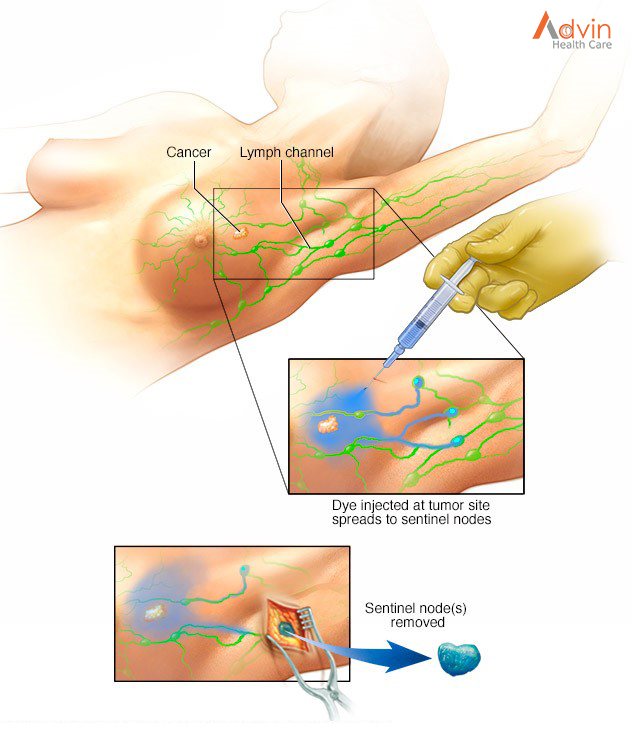Lumpectomy (lum-PEK-tuh-me) is surgery to remove cancer or other abnormal tissue from your breast.
During a lumpectomy procedure, the surgeon removes the cancer or other abnormal tissue and a small amount of the healthy tissue that surrounds it. This ensures that all of the abnormal tissue is removed.
Lumpectomy is also called breast-conserving surgery or wide local excision because only a portion of the breast is removed. In contrast, during a mastectomy, all of the breast tissue is removed. Doctors may also refer to lumpectomy as an excisional biopsy or quadrantectomy.
Lumpectomy is a treatment option for early-stage breast cancer. Sometimes lumpectomy is used to rule out a cancer diagnosis. When a lumpectomy surgery is performed to remove cancer, it usually is followed by radiation therapy to the breast to reduce the chances of cancer returning.
Why it’s done
The goal of lumpectomy is to remove cancer or other abnormal tissue while maintaining the appearance of your breast. Studies indicate that lumpectomy followed by radiation therapy is as effective in preventing a recurrence of breast cancer as removal of the entire breast (mastectomy) for early-stage breast cancer.
Your doctor may recommend lumpectomy if a biopsy has shown that you have cancer and that the cancer is believed to be small and early stage. Lumpectomy may also be used to remove certain noncancerous or precancerous breast abnormalities.
Your doctor may not recommend lumpectomy for breast cancer if you:
- Have a history of scleroderma, a group of diseases that harden skin and other tissues and make healing after lumpectomy difficult
- Have a history of systemic lupus erythematosus, a chronic inflammatory disease that can worsen if you undergo radiation treatments
- Have two or more tumors in different quadrants of your breast that cannot be removed with a single incision, which could affect the appearance of your breast
- Have previously had radiation treatment to the breast region, which would make further radiation treatments too risky
- Have cancer that has spread throughout your breast and overlying skin, since lumpectomy would be unlikely to remove the cancer completely
- Have a large tumor and small breasts, which may cause a poor cosmetic result
- Don’t have access to radiation therapy
What should I expect before a lumpectomy?
The details of your case (such as a tumor’s size or location) can affect how your breast looks after surgery. Your surgeon will review your imaging with the radiologist and design a surgical procedure which will focus on removing the entire cancer area.
In some cases, due to the larger size of the tumor, the breast surgeon may enlist the assistance of a plastic/reconstructive surgeon to perform combined team approach surgery called an oncoplastic lumpectomy. In an oncoplastic operation, the cancer is a bit bigger than suitable for a traditional lumpectomy (removing more than 20% of the breast volume), so the planned surgery takes into account the larger piece of breast tissue needing to be removed and allows for better scar placement, reshaping and nipple position. Often oncoplastic surgery requires a surgery on the other, normal breast to reduce the volume as well to match the cancer breast size.
It’s important to talk with your healthcare provider before surgery about how your breast may change. Your provider can tell you what breast surgery options are available.
Your provider will go over procedure details before surgery to help you feel comfortable about your care. Ask your provider to explain anything you don’t understand or are unsure about.
It’s important for your health and safety that you follow all of your provider’s instructions, such as when to stop taking certain medications before surgery.
Locating the area to be removed
Your lumpectomy procedure begins with locating the area of your breast that contains the abnormality (localization procedure). To do this, a doctor who uses imaging tests to diagnose and treat diseases (radiologist) uses a mammogram or ultrasound to locate the tumor and insert a thin wire, needle or small radioactive seed. Your surgeon uses this as a guide to find the precise area that needs to be removed during surgery.
If you have a lump or mass in your breast that can be easily felt through the skin, the localization procedure may not be necessary because the surgeon can more easily find the abnormal area to be removed.
Preparing for lymph node removal
Your surgeon may recommend removing lymph nodes near your armpit to see whether cancer has spread beyond the breast. Surgery to remove a few lymph nodes (sentinel node biopsy) is often recommended for early-stage breast cancer. If cancer was found in a lymph node before surgery or if there’s a concern that the cancer has spread, your surgeon may recommend removing a number of lymph nodes near your armpit (axillary lymph node dissection).
Lymph node removal procedures include
Sentinel node biopsy. During this procedure your surgeon removes only the first one or two nodes into which the cancer drains (sentinel nodes). These are then tested for cancer. Your doctor may recommend this procedure if there are no concerns about enlarged lymph nodes prior to your surgery.
Before your surgery, a radioactive substance or blue dye or both is injected into the area around the cancer or the skin above the cancer. The dye travels to the sentinel node or nodes, allowing your surgeon to identify and remove them.
If no cancer is present in the lymph nodes, no further lymph nodes need to be removed. If cancer is present, the surgeon will discuss options, such as receiving radiation to the armpit. If this is what you decide to do, you will not need to have more lymph nodes in the armpit removed.
Axillary lymph node dissection. During this procedure, the surgeon removes a number of lymph nodes from your armpit. Your surgeon may recommend this procedure if a lymph node biopsy done before surgery shows signs of cancer.
During the procedure

A lumpectomy is usually performed using general anesthesia, which will put you into a sleep-like state during the procedure.
Your surgeon will make an incision over the tumor or over the area that contains the wire or seed, remove the tumor and some surrounding tissue, and send it to the lab for analysis. He or she will do the same for the sentinel lymph node or nodes if you’re having a sentinel node biopsy or the axillary lymph nodes if you’re having an axillary lymph node dissection.
The surgeon will then close the incisions with attention to preserving the appearance of your breast, using stitches (sutures) that will either dissolve on their own or be removed later by your doctor. Your surgeon may also place thin adhesive strips or use glue on the incision to keep it closed until it heals.
After the procedure
After your surgery, you’ll be taken to a recovery room. During this time, your blood pressure, pulse and breathing will be monitored.
If you’ve had outpatient surgery — usually lumpectomy and sentinel node biopsy — you’ll be released when your condition is stable.
If you’ve had axillary lymph node dissection, you may need to stay in the hospital for a day or two if you’re experiencing pain or bleeding.
Expect to have:
- A dressing (bandage) over the surgery site
- Some pain, numbness and a pinching sensation in your underarm area
- Written instructions about post-surgical care, including caring for the incision and dressing and recognizing signs of infection
- Prescriptions for pain medication and possibly an antibiotic
- Some restrictions of activity
- A follow-up appointment with your doctor, usually seven to 14 days after surgery
Advin Lumpectomy Set
- Scalpel Handle
- Scalpel Blade
- Jabeley Scissors
- Metzenbaum Scissors
- Adson Tissue & Suture Forceps
- Gruenwald Bayonet Forceps
- Baby Crile Wood Needle Holder
- Jabeley Scissors Supercut
- Solz Gold Tip Scissors
- Faurabeuf Retractor
- Lengenback Retractor
- Atraumatic Breast Dissector
- Breast Hook Curved To Left
- Breast Hook Curved To Right
- Freeman Areola Marker
- Marx Breast Retractor
- Breast Elevator
- Round Bowl For Solution
- Mayo Heger Needle Holder



